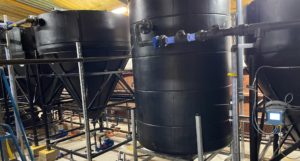How much will climate change destabilise the carbon cycle?

A new project will assess how much the natural carbon cycle could be destabilised by climate change.
The rate of climate change is partly determined by where carbon ends up.
Carbon released by burning fossil fuels and deforestation can end up in plants and soils, the ocean or the atmosphere – where it drives global warming.
Current climate models project a weakening of both land and ocean sinks (the amount of CO2 they absorb) – meaning a steeper rise in atmospheric CO2 and therefore warming.
But the models’ projections differ by a factor of five, hindering our ability to predict future climate change.
The new project – called Carbon Loss in Plants, Soils, and Oceans (CALIPSO) – is funded through a gift from the Virtual Earth System Research Institute (VESRI), an initiative of Schmidt Futures.
It co-led by the Laboratoire des Sciences du Climat et de l’Environnement, the University of Exeter and the University of East Anglia (UEA).
“Loss of carbon due to biological processes, such as tree mortality, are major gapsin our current knowledge of the carbon cycle, which have been ignored or oversimplified in current models, failing to reproduce the observed complexity of living systems,” said Philippe Ciais, senior researcher at Laboratoire des Sciences du Climat and coordinator of the CALIPSO project.
To understand the “fate of future CO2”, CALIPSO will assess carbon loss from plants, soils and the ocean, using new observations, theoretical understanding, machine-learning tools and integration of processes with Earth System Models.
The project will also investigate how increasingly frequent extreme events may trigger a destabilisation of biological carbon reservoirs.
To do this, CALIPSO scientists across six countries will develop biologically accurate representations including how climate change will impact the mortality and resilience of trees following drought and fire.
“Recent theoretical and empirical breakthroughs make it possible to change the paradigm from a ‘physically mediated’ to a ‘biologically mediated’ representation of the carbon cycle in climate models,” said Professor Pierre Friedlingstein, from the Global Systems Institute at the University of Exeter, one of CALIPSO’s prime investigators.
“New empirical datasets will be analysed in the project to reduce uncertainty on critical processes which could previously only be observed at a handful of locations: satellite constellations delivering daily spectral images of the whole Earth at metre resolution; compilations of thousands of measurements of functional traits for plants, soil microbes and ocean organisms; and millions of images from automated underwater cameras to map ocean particles and organisms.
“With new machine-learning methods, these high-dimensionality observations will guide the development of a new generation of carbon cycle models.”
UEA’s Professor Corinne Le Quéré, who leads the ocean research work in CALIPSO, said: “Theoryhas now progressed to extend the model representations of plant mortality, and organic matter decay and recycling processes in soils and in the ocean by microbial communities, including nutrient limitations and acclimation of ecosystems.
“This means models will be much more realistic and potentially sensitive to changes in the environment.”
The team expect that CALIPSO will make a giant leap in the representation of carbon-loss processes in climate models and fill in critical knowledge gaps in the global carbon cycle.
All the model codes and data collected in the project will be publicly available, to benefit the research community and help develop a new generation of models that will accurately predict the fate of future CO2 and climate change and the risks to our planet.



